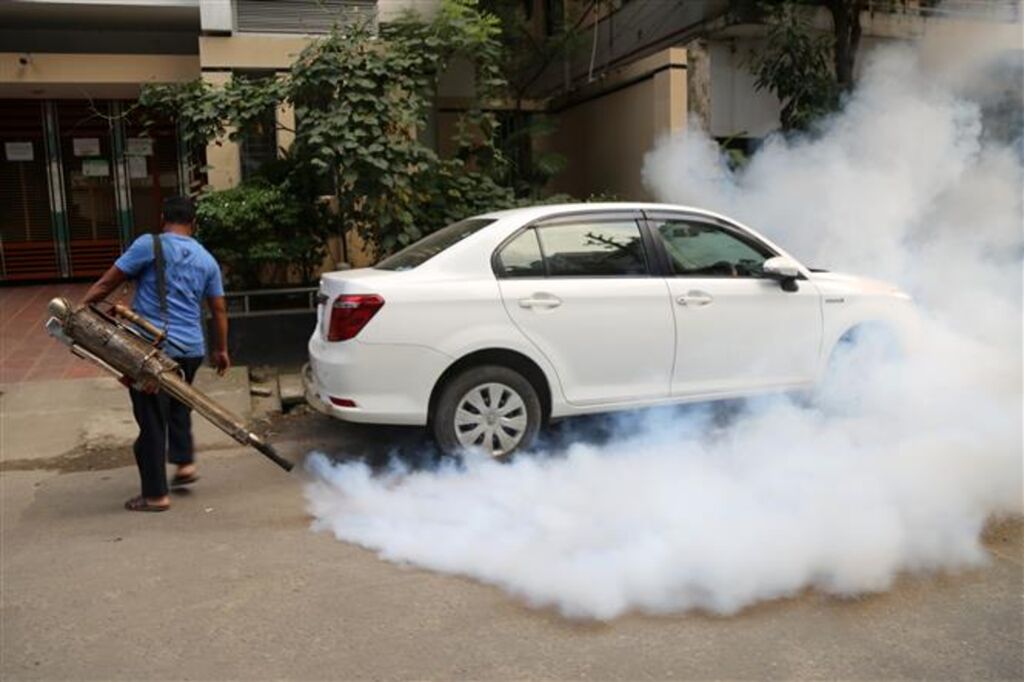New dengue alert in Bangladesh: the epidemic of fever, propagated by mosquitoes, has reappeared in hospitals in coastal districts of the country, forced to treat the sick on the ground.
>> Struck by an extreme heat wave, Bangladesh prays for the rain
>> The Philippines face the increase in cases of dengue
>> Bangladesh: eight dead and two million victims in floods
>> In Nepal, the disturbing reappearance of dengue
 |
| Spraying chemicals to kill mosquitoes in Dhaka, Bangladesh, October 20, 2024. |
| Photo : Xinhua/VNA/CVN |
At a time when global warming is changing the world weather in depth, experts impute this brutal resurgence of the virus with a lack of drinking water in the regions of the Brahmapoutre and Ganges rivers delta.
In Barisal (North), Azmeri Mona Lisa Zareen died from Dengue at the beginning of the month and her 2 -year -old girl is inconsolable.
“My wife has developed a high fever (…) Her tension fell and she couldn’t breathe, and the sound of the sanctuary, Rakibul Islam Ran, 31 years. Since her death, our daughter never stops looking for her everywhere “.
Almost half of the 7,500 cases recorded in Bangladesh in 2025 were in the Barisal district, according to the Institute of Epidemiology, Research and Disease Control (IEDCR).
Five patients died, for a total of 31 identified throughout the country this year.
These figures are still far from those noted during the episode of 2023, where more than 200,000 cases, including 1,700 mortals, had been counted.
But in the small locality of Barguna, the local head of health services, Shyamol Krishna Mondal, is formal. The current epidemic is “The worst never seen” in its sector.
More than 200 dengue patients have already been hospitalized there. “We have no more beds for themhe assures, We take care of people on the ground “.
Epidemiologist at the University of Dacca, Kabirul Bashar estimates that the lack of drinking water is “One of the main causes” recent outbreak of dengue.
“Stagnant waters”
“The drinking water distribution system is almost nonexistent” In some regions of the country of 170 million inhabitants, he notes.
Result, many of them are forced to use, for their essential needs, with rainwater which they store in containers, which promotes the development of mosquitoes carrying the disease.
In addition, scientists note, climate change multiplies storms, which propagate salt water more inside the land, contaminating wells and lakes.
“You have to do everything to avoid the multiplication of stagnant waters. The rule should be intangible, unfortunately this is not the case”deplores Mushtuq Husain, specialist in public health and advisor to the IEDCR.
“The increase in temperatures and increasingly erratic precipitation, conducive to the reproduction of mosquitoes, only increase our vulnerability”he insists.
Dengue has been present in Bangladesh since the 1960s, but the health authorities have identified the first epidemic in 2000.
The World Health Organization (WHO) has recently warned against the risks of dengue and other infections conveyed by mosquitoes, thanks to warming temperatures.
Almost half of the world’s population is now considered threatened by these diseases, according to WHO, which lists each year from 100 to 400 million cases of dengue.
In Barisal, Rakibul Islam Rajan fears that his wife is only one of the first victims and reproaches the authorities for not making it enough against the proliferation of mosquitoes.
“My wife died from dengue, I don’t know how many others will followhe worries. And I don’t see much cleaning “.
AFP/VNA/CVN

